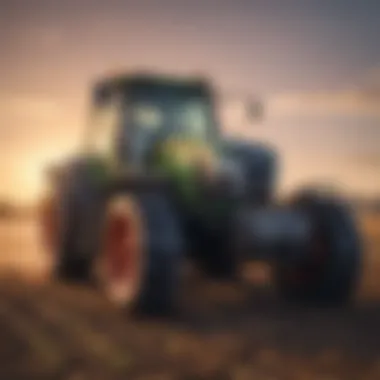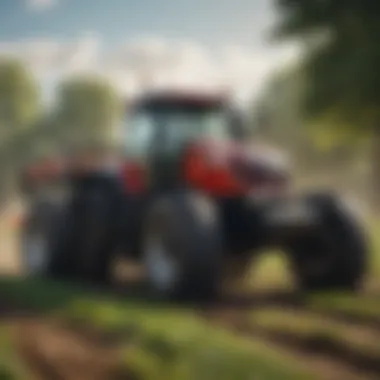Unpacking Brand New Engines in Agriculture and Horticulture


Intro
The agricultural and horticultural sectors are undergoing a significant transformation. This change is fueled by the introduction of new technologies and innovative practices that are significantly altering farming and gardening methods. The article provides an in-depth exploration of these advancements, particularly focusing on what these brand new engines are and how they impact agronomy and crop management. Understanding these developments is crucial for agricultural professionals, students, and enthusiasts alike. They play a pivotal role in shaping the future of food production and environmental sustainability.
Latest Trends in Agriculture
Overview of Current Trends
In the realm of agriculture, several prominent trends have surfaced. Among these, precision agriculture has gained considerable traction. This approach leverages data analytics, GPS technology, and IoT devices to optimize field-level management regarding crop farming. Farmers can collect real-time data, assess soil health, and monitor crop progress efficiently. This maximizes yield while minimizing resource waste.
Vertical farming is another noteworthy trend. This method involves growing crops in stacked layers, often using hydroponics or aeroponics. It allows for more efficient land use and can produce food in urban areas, reducing transportation costs and carbon footprint. The integration of artificial intelligence, machine learning, and robotics is expected to enhance these methods even further.
Impact of Technology on Farming Practices
Technology has transformed traditional farming practices into more streamlined, efficient processes. Farmers are utilizing drones for field surveys, which provide insights into crop health and help in applying fertilizers and pesticides more accurately. This results in reduced chemical use and promotes sustainable practices.
Robotics is also revolutionizing agriculture. Mechanized equipment for planting, harvesting, and maintaining crops is becoming common. This not only alleviates labor shortages but also increases productivity and consistency in farming operations. Moreover, the use of data-driven decision-making enhances overall farm management.
"The integration of modern technology in agriculture allows for more sustainable farming and enhances productivity, marking a significant shift toward a data-driven approach."
Sustainable Practices: Towards a Greener Future
Importance of Sustainability in Agriculture
Sustainability has become a focal point in agricultural practices. With the rising concerns about climate change and food security, adopting sustainable practices is essential. Sustainable agriculture aims to meet current food needs without compromising future generations' ability to produce food.
Implementing sustainable practices can lead to improved soil health, reduced dependency on chemical fertilizers, and enhanced biodiversity. It involves using natural resources efficiently while minimizing environmental impact.
Methods for Sustainable Farming
There are various approaches to sustainable farming. Crop rotation is one such technique that helps maintain soil fertility. Integrating cover crops can prevent soil erosion and enhance water retention.
Another effective method is agroecology, which combines agricultural practices with ecological principles. This allows for a more holistic approach to managing farming systems. Using organic farming methods can also help in minimizing pollution and building healthier ecosystems.
Gardening Techniques and Tips
Essential Gardening Tools and Equipment
A well-equipped garden is crucial for success in horticulture. The basic tools that every gardener should have include spades, rakes, and pruning shears. These tools help in maintaining garden health and ensuring better yields. Additionally, using equipment like soil testers can provide valuable insights into soil quality, enabling better plant growth.
Seasonal Gardening Practices
Gardening techniques often vary with the seasons. In spring, a gardener should focus on soil preparation, selecting the right plants, and planting seeds. During summer, regular watering and pest control become vital to ensure plant health. In the fall, activities shift toward harvest, saving seeds for the next season, and preparing the garden for winter. Each season presents unique challenges and opportunities, which require different strategies for effective management.
Understanding these trends and practices is essential for any agricultural or gardening endeavor. As technology continues to evolve, staying informed about advancements will enhance productivity and sustainability in both agriculture and horticulture.
Prelude to Brand New Engines
In recent years, agriculture and horticulture have seen a significant transformation due to technological advancements. This section aims to highlight the relevance of new engines within these fields, focusing on their implications for productivity, sustainability, and efficiency.
Definition and Relevance
Brand new engines refer to innovative technologies and systems that enhance operational efficiency in farming and gardening. These can include autonomous machinery, advanced irrigation systems, and robotics tailored for specific agricultural tasks. Understanding these engines is crucial for farmers and enthusiasts, as they directly impact crop yields and environmental sustainability.
The integration of advanced engines into agriculture signifies a shift towards modernized practices. Innovations in this area are not merely trends but essential tools to adapt to challenges such as climate change, labor shortages, and rising consumer demands. With new engines, agri-businesses can optimize their operations, reduce waste, and improve the quality of produce. This adaptation is not just beneficial but necessary in a highly competitive market.


Historical Context
The evolution of agricultural practices can be traced back thousands of years. From the invention of the plow to the mechanization of farming in the early 20th century, each advancement has reshaped how food is produced. The introduction of tractors and mechanized harvesters marked a significant turning point, allowing for greater efficiency and scale.
In the latter half of the 20th century, a push for increased yields led to the Green Revolution. This period saw the adoption of synthetic fertilizers, pesticides, and high-yield crop varieties. However, while these innovations made farming more productive, they also brought challenges such as soil degradation and chemical dependence.
Today, we stand at a crossroads where technological innovations once again promise to reshape the landscape of agriculture and horticulture. As we evaluate the significance of new engines, it is essential to learn from history to avoid repeating past mistakes, particularly regarding sustainability and environmental health. Understanding both the advancements and the history leading to them provides a clearer perspective of the path forward in enhancing agricultural methodologies.
Technological Advancements in Agriculture
Technological advancements play a critical role in modern agriculture. They enhance productivity and ensure sustainability, allowing farmers to meet increasing food demands while minimizing resources. The landscape of agriculture is evolving, with technology integrating deeply into traditional practices. This section delves into key elements such as precision agriculture and automation, which are pivotal for today’s agronomist.
Precision Agriculture
Precision agriculture is revolutionizing farming techniques. It involves using technology to monitor and manage field variability in crops. With tools such as GPS and IoT (Internet of Things) devices, farmers can gather data on soil conditions, moisture levels, and crop health.
- Benefits of precision agriculture include:
- Improved crop yields through targeted applications of water and fertilizers.
- Reduced wastage of resources, which leads to cost savings.
- Enhanced environmental sustainability by minimizing chemical runoff into ecosystems.
For instance, many farmers now use drones equipped with sensors to assess their fields. These drones can quickly analyze large areas while collecting critical data, allowing farmers to make informed decisions in real-time. The shift from a one-size-fits-all approach to tailored strategies is monumental in optimizing agricultural productivity.
Automation and Robotics
Automation in agriculture is another major advancement gaining traction. From automated irrigation systems to robotic harvesters, technology is changing how farming operations are carried out. Automation increases efficiency by performing repetitive tasks that traditionally require human labor.
- Key aspects of automation and robotics include:
- Labor Efficiency: Reduces the need for manual labor, making farms less vulnerable to worker shortages.
- Consistency and Precision: Machines can perform tasks with high accuracy, ensuring uniform application of treatments across the field.
- Data Collection: Automated systems collect vast amounts of data, which is essential for refining future farming processes.
As these technologies evolve, they will likely lead to an enhanced labor landscape in agriculture.
Innovations in Horticulture Practices
The landscape of horticulture is evolving rapidly, driven by technological advancements that enhance productivity and sustainability. Innovations in horticulture practices have not only improved crop yields but also allowed for more efficient resource management. They support the growing demand for food while addressing environmental concerns. This section delves into two specific innovative practices: vertical farming and hydroponics/aquaponics.
Vertical Farming Techniques
Vertical farming represents a shift in how crops can be cultivated. By utilizing vertical space, growers can produce more food in a smaller area. This technique is beneficial for urban settings where land is scarce and expensive. In essence, vertical farming can lead to:
- Increased yield per square foot: Growing upwards allows for multiple layers of crops, effectively maximizing the planting area.
- Reduced transportation costs: Farms can be established closer to urban centers, reducing the distance food travels.
- Less dependency on weather: Controlled environments minimize the impact of adverse weather conditions, leading to more consistent harvests.
While these benefits are significant, vertical farming comes with its own set of challenges. The initial setup costs can deter many potential growers. Additionally, it requires advanced technology, such as specialized lighting and climate control systems, which can complicate operations. It is crucial for practitioners to weigh these factors before investing in vertical farming technologies.
Hydroponics and Aquaponics
Hydroponics and aquaponics are alternative growing methods that do not rely on soil. Hydroponics utilizes nutrient-rich water to grow plants, while aquaponics combines this system with fish farming. This dual partnership creates a symbiotic environment:
- Efficient resource use: Both systems require significantly less water compared to traditional farming methods. They can reduce consumption by up to 90%.
- Faster growth rates: Without the need for soil, plants can access nutrients more efficiently, leading to quicker harvest cycles.
- Sustainable practices: Aquaponics, in particular, supports sustainable agriculture by creating a closed-loop system where waste from fish becomes fertilizer for plants.
Despite these advantages, challenges remain. Hydroponic systems can be complex to maintain, and the initial setup can be costly. For aquaponics, ensuring proper balance between plants and fish is essential, requiring careful monitoring.
"The future of horticulture must align with innovation to meet the food demands of a growing population."
Environmental Impact of New Engines
The introduction of brand new engines in agriculture and horticulture carries significant environmental implications. The design and functionality of these engines not only influence agricultural productivity but also affect ecosystems, biodiversity, and resource management. It's critical to assess how these engines align with sustainability goals to ensure that they do more good than harm. By integrating advanced technology, farmers can benefit from improved efficiency while also minimizing negative impacts on the environment.


Sustainability Considerations
Sustainability is a fundamental aspect when discussing new engines in agriculture. These engines should enhance productivity without depleting natural resources. Key considerations include:
- Resource Efficiency: New engines often utilize resources such as fuel and water more effectively. Innovations like low-emission engines reduce fuel consumption, leading to less environmental degradation.
- Biodiversity Preservation: Smart engines can help minimize disturbance to ecosystems. For instance, precision agriculture techniques allow for targeted intervention, preserving surrounding habitats and species.
- Soil Health: Introducing engines that support regenerative practices fosters soil health. Equipment designed for minimal tillage helps in maintaining soil structure, leading to better water retention and less erosion.
Moreover, adopting practices that focus on sustainability is not only beneficial for the environment but can enhance product quality and yield, promoting economic viability. As stakeholders adopt these practices, they contribute to a larger goal of sustainable agriculture.
Carbon Footprint Reduction
Reducing the carbon footprint is crucial in combating climate change. The transition to brand new engines offers unique opportunities to lower emissions in agriculture and horticulture. The following points highlight the importance of this reduction:
- Advanced Fuel Options: Many new engines are compatible with alternative fuels. Options like biofuels generate fewer emissions, which significantly lowers the greenhouse gases released during operation.
- Energy-efficient Technologies: Electric engines and hybrids represent a shift toward cleaner energy. By reducing reliance on fossil fuels, these technologies decrease both direct and indirect carbon emissions.
- Smart Agricultural Practices: Automation in farming enhances precision. These practices reduce the overall machinery operational time, which directly correlates to lower emissions per unit of produce.
"The adoption of clean technologies is essential for the future of agriculture, paving the way for significant emission reductions."
Economic Implications
Economic implications of new engines in agriculture and horticulture are vital as they determine the viability and sustainability of adopting advanced technologies. Investment in new engines affects not just yields but also overall profitability within the sector. The shift towards modern machinery creates opportunities, challenges, and a need for strategic planning. Understanding these economic factors is essential for stakeholders to make informed decisions that can lead to improved operational efficiency and enhanced market competitiveness.
Cost-Benefit Analysis
A cost-benefit analysis is paramount in assessing the economic impact of new engines. This process involves comparing the initial costs of purchasing and implementing advanced machinery against the expected benefits in terms of productivity and efficiency.
- Initial Investment: The cost of cutting-edge engines can be high. Farmers and horticulturists must consider both direct costs, such as equipment prices, and indirect costs, like maintenance and training.
- Increased Yields: New engines often lead to higher productivity. For instance, precision agriculture technology helps in optimizing resource use, which can lead to improved crop yields.
- Operational Efficiency: Modern engines tend to operate faster and more efficiently. This reduction in operation time can significantly lower labor costs while increasing the acreage a farmer can manage.
- Long-term Savings: Investing in new engines may create long-term savings through reduced fuel consumption and maintenance costs. Although the upfront expenditure may seem daunting, the return on investment over time can justify the initial outlay.
The analysis should provide a clear picture of when and how these investments make economic sense.
Market Trends
Market trends illustrate how the agricultural and horticultural sectors are evolving. These trends are influenced by technological advancements, consumer demands, and regulatory changes.
- Increased Demand for Automation: As labor shortages become more pronounced, there is a growing inclination towards automated solutions. This trend suggests a steady market shift towards machinery capable of performing tasks without constant human oversight.
- Sustainability Preferences: Consumers increasingly prefer sustainably sourced products. This demand nudges agricultural practices towards eco-friendly engines that lower emissions and conserve resources, thus affecting market dynamics.
- Rise in Smart Farming: The integration of IoT and data analytics into farming practices has led to a surge in smart farming solutions. These solutions are fetching higher prices in the market, reflecting the value placed on efficient and informed agricultural practices.
- Global Competition: As global markets become more integrated, local producers must stay competitive. The necessity for high-quality production at lower costs places economic pressure on stakeholders to adopt state-of-the-art engines.
Challenges in Implementation
The implementation of brand new engines in agriculture and horticulture is crucial for enhancing productivity and sustainability. However, several challenges hinder effective adoption. These challenges are multifaceted, including infrastructure limitations and skill gaps among practitioners. Identifying and understanding these challenges can guide stakeholders in developing strategies to mitigate them and maximize the benefits of new technologies.
Infrastructure Limitations
Infrastructure plays a significant role in the successful integration of new engines into agricultural and horticultural practices. Many regions lack the necessary facilities to support advanced technologies. For instance, areas with poor road networks and inadequate storage facilities face difficulties in transporting crops and inputs, impacting overall efficiency.
Moreover, the existing irrigation systems often do not align with modern techniques, such as precision agriculture. Updating equipment is often costly and requires substantial investment, which can be a barrier for many farmers, especially smallholders. Additionally, reliance on traditional farming methods can further complicate the transition. Farmers who are accustomed to conventional practices may need time to adjust to new technologies.
To address these limitations, local governments and organizations could collaborate to improve infrastructure. Investing in roads, irrigation, and storage facilities will create a more conducive environment for innovative practices.
Skill Gaps among Practitioners
The skill gap among agricultural practitioners is another significant challenge. As new engines and technologies emerge, the demand for a skilled workforce increases. However, many farmers and workers may not have the necessary training to operate advanced machinery or to implement sophisticated farming techniques effectively.
Educational programs focused on modern agricultural practices can help bridge this skills gap. Initiatives by vocational schools and agricultural colleges, aimed at training future professionals in new technologies, are essential. Moreover, workshops and hands-on training can equip current practitioners with the knowledge they need.
"Continuous education and adaptability are crucial for embracing innovation in agriculture."
Addressing these skill gaps is vital for ensuring the successful implementation of new engines. Engaging local universities and organizations could facilitate knowledge transfer and skills development.


Case Studies of New Engine Applications
The exploration of case studies related to new engine applications in agriculture and horticulture is crucial. These examples not only highlight the practical implementation of recent technological advancements but also assist professionals and enthusiasts in understanding how these innovations evolve practices on the ground. They serve as tangible evidence of the capabilities and effectiveness of new solutions, making the concept clearer.
Case studies often showcase methods, results, and outcomes that can easily inform decision-making. Moreover, by examining real-world applications, stakeholders can assess both successful strategies and challenges encountered during implementation. These insights can significantly guide future endeavors and foster a culture of innovation and adaptation.
Successful Agricultural Practices
In the realm of agriculture, engines represent a spectrum of advanced technologies. One prominent example is the use of precision agriculture tools developed by companies like John Deere. Their equipment integrates GPS technology to optimize field work. By utilizing these technologies, farmers can achieve higher crop yields while minimizing resource inputs.
Another successful practice includes the adoption of crop monitoring drones. These drones capture data on plant health and moisture levels. Farmers such as those in California have demonstrated marked success in yield improvement through timely interventions based on drone insights. The ability to analyze crops from above offers a more comprehensive view, leading to informed irrigation and fertilization decisions.
Furthermore, the introdcution of smart irrigation systems like those made by Netafim has altered the landscape. They use sensors to measure soil moisture levels and adjust water delivery accordingly. This has led to conservaton of water use while optimizing crop health.
"The effective use of new engines in agriculture not only improves output but also promotes sustainable practices."
Innovative Horticultural Projects
Turning to horticulture, innovative projects shine a spotlight on the potential of new engines. A leading example is the introduction of vertical farms, such as those by Plenty. They utilize LED lighting and automated growing systems to produce leafy greens in urban areas. The technology optimizes space and resources, manifesting in substantial decreases in water usage and transportation emissions.
Additionally, systems integrating hydroponics technology, like those offered by AeroGarden, showcase creativity in plant growth without traditional soil. Horticulturists have found that such setups can yield faster-growing plants and higher quality produce. The adaptability of these systems to various environments makes them appealing, especially in locations with limited arable land.
Innovations in intelligent greenhouse management, exemplified by systems from companies like Greenhouse Megastore, also demonstrate potential. By utilizing sensors that monitor various environmental factors, growers can adjust conditions in a data-driven way. This not only increases plant productivity but also enhances product quality.
Future Outlook for New Engines
The exploration of brand new engines in agriculture and horticulture extends far beyond their mere technological innovations. This section delves into the upcoming trends, shedding light on how emerging technologies are setting the course for substantial progress in farming practices and plant cultivation. Understanding this future outlook holds critical significance for industry professionals and enthusiasts, considering the potential transformations these innovations could create.
Emerging Technologies
Recent advancements in technology are reshaping agricultural practices and horticultural approaches. For instance, artificial intelligence plays a significant role in precision farming. Algorithms analyze various data points, from soil health to weather patterns, helping farmers make informed decisions. Drones equipped with advanced sensors are another remarkable innovation. They monitor crop health, provide aerial imagery, and even assist in planting seeds, providing valuable insights that enhance yield productivity.
Moreover, Internet of Things (IoT) devices are becoming commonplace on farms. They collect real-time data that can be utilized to improve resource management. Sensors placed in the field relay information about moisture levels, nutrient content, and crop conditions, allowing farmers to respond swiftly to any changes. This interconnected investment not only improves efficiency but can greatly reduce waste, thereby leading to greater profitability.
A notable area of progress is biotechnology, where genetic engineering is being applied. Crops are being developed to be more resilient against pests and diseases, diminishing reliance on chemical pesticides. Innovations in biopesticides and biofertilizers are also gaining traction, suggesting a shift toward more sustainable practices while maintaining productivity levels.
Potential for Sustainable Development
Sustainable development is a vital aspect when considering the future of agriculture and horticulture. The integration of new engines could pave the way for sustainable practices that align with global environmental goals. This aligns with the increasing pressure on agricultural systems to mitigate their environmental impact while meeting the food demands of a growing population.
Deploying innovative techniques such as vertical farming maximizes land use efficiency. As urbanization continues, these farming systems can supply fresh produce with minimal land requirements. Similarly, hydroponics and aquaponics offer promising methods that require less water than traditional farming methods, potentially addressing water scarcity issues.
The shift towards new energy sources, such as solar and wind, also contributes positively to sustainable agriculture. Utilizing renewable energies reduces dependence on fossil fuels and lowers greenhouse gas emissions. This transition not only supports environmental conservation but also enhances long-term economic resilience for agricultural practitioners.
In summary, the future outlook for new engines in agriculture and horticulture is promising. By embracing emerging technologies and sustainable practices, stakeholders can navigate the challenges ahead while promoting an efficient, environmentally conscious agricultural landscape.
The incorporation of advanced technologies in the agricultural sector symbolizes a shift towards smarter and more sustainable farming practices.
Ending
In this article, we examined the complexities surrounding brand new engines in agriculture and horticulture. This discussion is crucial as it brings to light various aspects of innovation that can significantly change practices on the ground.
Recap of Key Insights
To summarize, brand new engines have diversified how agricultural and horticultural tasks are performed. Key insights from the article include:
- Technological advancements such as precision farming and automation contribute significantly to increased productivity.
- Environmental sustainability is enhanced through modern practices, reducing carbon footprints and encouraging responsible resource management.
- Economic implications are prominent, with thorough cost-benefit analyses revealing both immediate and long-term financial advantages.
- Infrastructure and skill gaps pose challenges that must be addressed to fully leverage these new technologies.
- Case studies demonstrate successful applications that serve as benchmarks for future developments.
Call for Continued Innovation
The landscape of agriculture and horticulture is constantly evolving. Continuous innovation is essential for staying ahead of challenges and maximizing benefits. Encouraging collaboration among practitioners, researchers, and technology developers can unlock new possibilities. It is vital to invest in education and training programs that address current skill gaps. As we look to the future, fostering an ecosystem where ideas thrive will be key. Continued research into emerging technologies will also play a critical role in shaping sustainable practices.
By focusing on new engines, we can create a more efficient, sustainable, and profitable agricultural and horticultural sector.







